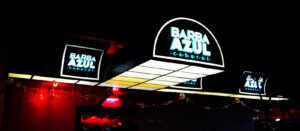The work of the Canadian director, form Québec, Robert Lepage, is undoubtedly characterized by innovation, experimentation and the integration of technology in each of his works.
887 is a dramatic text that in its illustrated version does not escape the technological integration on the part of its author. This work is specifically a monologue that focuses on the personal history of Robert Lepage, which deals with the time of his childhood-adolescence and his subsequent admission to the Conservatory of Dramatic Art of Quebec at the age of 17. 887 is the number of Murray Avenue in the Montcalm neighborhood of Quebec City, Canada, where Lepage lived part of his childhood-adolescence.
In this text, Lepage’s personal history is intermingled with the history of Quebec from the 1960s to 1970s. Lepage, through this text, recounts the moment when the Canadian flag was created, the visit to the country of important personalities like that of the French general-president Charles de Gaulle, as well as the activities of the Québec political activist Pierre Bourgault – who enthusiastically defended the independence of Québec.
Throughout the story, Lepage reveals the division of social classes that existed at that time, and tells how during his adolescence he was denied access to a famous school for the simple fact of being the son of a taxi driver.
Despite the stark narrative that unfolds to depict that time, 887 is full of humor and other more pleasant anecdotes and memories of Canadian national life and those of the author himself. This text is undoubtedly the most autobiographical, and the most local in color that Robert Lepage has written and addressed on stage: it is, a tribute to his family, a love song dedicated especially to his father.
Already on stage, this monologue is narrated in the first person, and if there is an intervention by other characters, it is given by metonymies, evocations, screen projections, recorded voices and direct allusions. The didascalias indicate exactly the movement of the scenery during the show and / or of the scenic elements found there. In a didascalia of the text, we can find indications such as: The wall-screen opens in the middle as if it were a curtain, and reveals an authentic smaller screen on which the phone number 681-5031 is projected (Lepage, 2016, p.15). Or indications such as: He takes a portable phone out of his bag and uses it as a remote control. He points to the screen, and brings up the following address: 887, Murray Avenue (Ibid. P.16). In this sense, thanks to the precise indications in the didascalias, the illustrated edition of 887 is an extension of the staging, which goes beyond a simple reading of a dramatic text.
It should be mentioned that the show has little more than sixty-two changes of scenic spaces that go from the intimacy of the room that Lepage shared with his little sister, to a large avenue where a parade takes place, passing through several departments, the facades of a complete building, and even the theater itself where we are witnessing the show. All these indications of changes in scenery and place, which occurred during the show, are precisely indicated in the didascalias. This description tries to be completely faithful to what happened in the show. If the reader was fortunate enough to witness the event, the memories of each sequence of the staging quickly come to mind. And it is here, where the interesting thing about the book, in terms of technological innovation, enters the scene.
To complete and reinforce our memories of the staging, Robert Lepage relies, in principle, on the illustrator Steve Blanchet to graphically recreate certain passages and elements of the staging. These illustrations are conceived in the graphic style of advertising in the 1960s and 1970s in Quebec.
Despite the stark narrative that unfolds to depict that time, 887 is full of humor and other more pleasant anecdotes and memories of Canadian national life and those of the author himself.
Second, Lepage uses, as usual, his team of interdisciplinary creators from his company Ex Machina, to produce 3D images. The new technological ingredient that Robert Lepage adds to the reading of his work in an illustrated version is what is known in the world of audiovisual creation as “augmented reality”. That is, tangible physical elements such as illustrations on a book page, are combined with virtual elements on the screen, to create, never mind the redundancy, an augmented reality in real time.
The book has 164 pages and is accompanied by an application that can be downloaded from the various multimedia content viewing platforms. Whether we have a tablet or even a portable phone, certain pages of the book will be able to play various passages found in the stage montage.
That means, that through our device, once placed in front of a certain illustration of the book, a video or audio image will be launched. In this way, we can have access to videos that were screened during the show, audios and animations that we can watch and listen to again to recreate a specific sequence.
I believe that Robert Lepage once again reaffirms himself as the cutting edge of the contemporary theatrical avant-garde, by innovating with this illustrated edition of a dramatic text, being able to integrate audiovisual technology and make the reading experience interactive; giving us a new horizon of what theater could become, by drawing on other disciplines.
Bibliographic information of the reviewed book.
Robert Lepage. 887. Montréal: Québec Amérique, 2016, 164 pp.
He has been working as an interdisciplinary artist-researcher since 1993. Doctor of Arts from the University of Quebec. He is currently working with the notion of cinematographic performance for the creation of puppet shows with live video.


